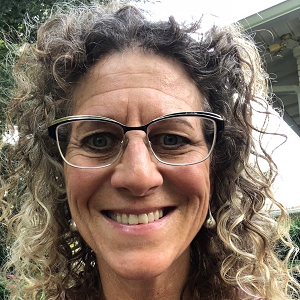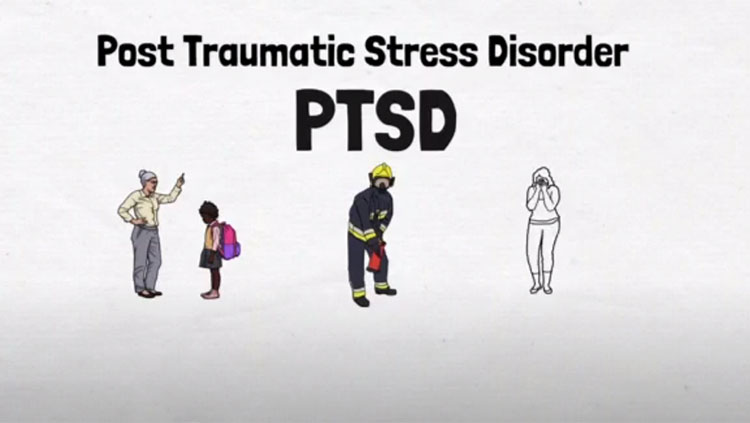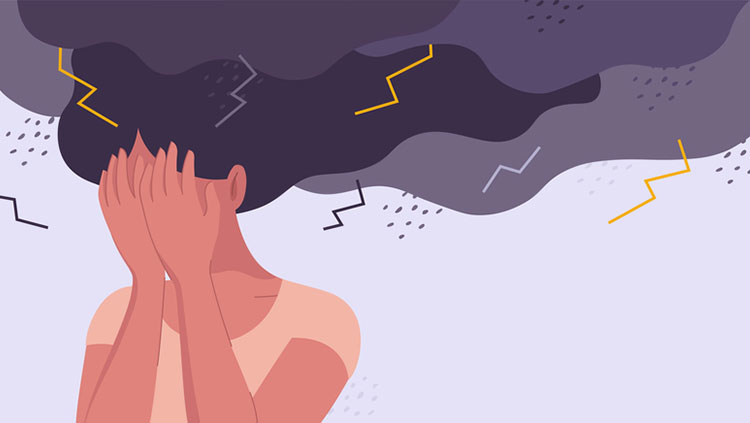Obsessive-Compulsive Disorder: An Overview
- Reviewed31 Jul 2023
- Author Alison Davis
- Source BrainFacts/SfN

It’s not uncommon for people to get fixated on their anxieties. And we sometimes have behaviors, habits, or rituals that help us quell our anxious thoughts. For some individuals, these anxious thoughts can be uncontrollable, recurring, and prolonged — leading people to try mitigating their obsessions through compulsive, repetitive behaviors or mental rituals that can lead to significant disruptions in their daily lives.
Obsessive-compulsive disorder (OCD) is a common condition aptly named for its symptoms: uncontrollable, recurring thoughts (obsessions), and ritualistic behaviors or thoughts (compulsions) to banish, relieve, or compensate for these obsessions. OCD affects about 1% of U.S. adults, with an average diagnosis by age 19. Obsessions vary widely: A person may, for example, persistently worry about getting sick from a contaminated object or repeatedly feel a mistake they could make may lead to disaster. Compulsions attempt to counteract those thoughts — for example, by excessive hand washing or constantly checking to mitigate against potential problems such as leaving appliances on. People with OCD are burdened by their obsessive thoughts and, although compulsive behaviors or thoughts can provide a reprieve, they do not bring peace. Engaging in compulsions may provide short-term relief from obsessions, but it simultaneously maintains the disorder as the relief from the compulsion reinforces the larger cycle of obsessions and compulsions.
Research studies that examine the brain with powerful imaging tools have enabled neuroscientists to identify the brain regions involved in obsessions and compulsions. One such region, the basal ganglia, connects with the cortex to help control our ability to move and think, but it also helps us conduct routine behaviors like our habits. OCD generally involves dysfunction in brain areas like the caudate nucleus and putamen (parts of the basal ganglia), the orbitofrontal cortex, cingulate gyrus, globus pallidus, thalamus, and the frontal cortex. Although dysfunction in this network of regions has been implicated in OCD, there is no connection linking this dysfunction to be the cause of OCD.
Researchers suspect that disrupted signaling between the basal ganglia and the cortex could set the stage for ritualistic behaviors. Studies of repetitive behaviors in mice have revealed electrical activity that starts and ends in nerves that connect these two brain regions. The ability to manipulate those circuits have sometimes provided small, short-term benefits for breaking the obsession-compulsion cycle in people with OCD.
About 70% of people undergoing cognitive behavioral therapy (CBT), a form of counseling, improve significantly without medications. A common form of CBT used for OCD is exposure and response prevention (ERP). The exposure component of ERP allows people to practice confronting the thoughts, images, objects, and situations that make them anxious or provoke obsessions. The response prevention portion then allows for people to make a choice not to engage in a compulsive behavior once the anxiety or obsessions have been triggered. CBT can be very useful and even normalize function in brain areas implicated in OCD-related dysfunction.
People with OCD obtain limited relief with medication, primarily selective serotonin reuptake inhibitors (SSRIs) at higher doses than are used for depression therapy. If SSRIs do not work to control OCD, other approaches include medications such as the tricyclic antidepressant clomipramine and neuroleptic (tranquilizing) drugs, both of which have significant side effects. In 2018, the FDA approved transcranial magnetic stimulation (TMS), a procedure using magnetic fields to electrically stimulate nerve cells in the brain from outside of the skull, for use in the treatment of OCD in adults.
Deep brain stimulation (DBS) is a therapeutic approach used for people with OCD who do not respond to standard drug or behavioral treatments. DBS was first used about 35 years ago to treat movement disorders like Parkinson’s disease but is now being investigated for other uses. In DBS, electrodes implanted at specific brain locations emit high-frequency electrical pulses intended to reset abnormal neuronal firing. Scientists are beginning to explore the use of DBS in the basal ganglia and several other brain regions to alleviate symptoms of OCD. Other types of brain surgeries are sometimes used as OCD interventions, namely anterior cingulotomies and anterior capsulotomies. These procedures involve drilling through the skull and using a heated probe to burn an area within a specific brain region for OCD symptom relief.
Adapted from the 8th edition of Brain Facts by Alison Davis.
CONTENT PROVIDED BY
BrainFacts/SfN
References
American Psychiatric Association. (2023). Diagnostic and Statistical Manual of Mental Disorders (5th ed., text rev.). https://doi.org/10.1176/appi.books.9780890425787
Bandelow, B., & Michaelis, S. (2015). Epidemiology of anxiety disorders in the 21st century. Dialogues in Cclinical Nneuroscience, 17(3), 327–335. https://doi.org/10.31887/DCNS.2015.17.3/bbandelow
Burguière, E., Monteiro, P., Mallet, L., Feng, G., & Graybiel, A. M. (2015). Striatal circuits, habits, and implications for obsessive-compulsive disorder. Current Oopinion in Nneurobiology, 30, 59–65. https://doi.org/10.1016/j.conb.2014.08.008
Cleveland Clinic. (2023). Panic Attacks & Panic Disorder. https://my.clevelandclinic.org/health/diseases/4451-panic-attack-panic-disorder
Craddock, N., & Sklar, P. (2013). Genetics of bipolar disorder. Lancet (London, England), 381(9878), 1654–1662. https://doi.org/10.1016/S0140-6736(13)60855-7
Foland-Ross, L. C., Hamilton, P., Sacchet, M. D., Furman, D. J., Sherdell, L., & Gotlib, I. H. (2014). Activation of the medial prefrontal and posterior cingulate cortex during encoding of negative material predicts symptom worsening in major depression. Neuroreport, 25(5), 324–329. https://doi.org/10.1097/WNR.0000000000000095
Geddes, J. R., & Miklowitz, D. J. (2013). Treatment of bipolar disorder. Lancet (London, England), 381(9878), 1672–1682. https://doi.org/10.1016/S0140-6736(13)60857-0
Kavanagh, D. H., Tansey, K. E., O'Donovan, M. C., & Owen, M. J. (2015). Schizophrenia genetics: emerging themes for a complex disorder. Molecular Ppsychiatry, 20(1), 72–76. https://doi.org/10.1038/mp.2014.148
Memon, M. A. (2018). Panic Disorder. Medscape. http://emedicine.medscape.com/article/287913-overview
National Alliance on Mental Illness. (2017). Depression. https://www.nami.org/Learn-More/Mental-Health-Conditions/Depression
National Institute of Mental Health. (2017). Anxiety Disorders. NIH. https://www.nimh.nih.gov/health/topics/anxiety-disorders/index.shtml
National Institute of Mental Health. (2017). Bipolar Disorder. NIH. https://www.nimh.nih.gov/health/statistics/prevalence/bipolar-disorder-among-adults.shtml
National Institute of Mental Health. (2017). Depression. NIH. https://www.nimh.nih.gov/health/topics/depression/index.shtml
National Institute of Mental Health. (2017). Obsessive-Compulsive Disorder (OCD). NIH. https://www.nimh.nih.gov/health/topics/obsessive-compulsive-disorder-ocd/index.shtml
National Institute of Mental Health. (2017). Panic Disorder. NIH. https://www.nimh.nih.gov/health/statistics/prevalence/panic-disorder-among-adults.shtml
National Institute of Mental Health. (2017). Post-Traumatic Stress Disorder (PTSD). NIH. https://www.nimh.nih.gov/health/statistics/prevalence/post-traumatic-stress-disorder-among-adults.shtml
Pittenger, C., & Bloch, M. H. (2014). Pharmacological treatment of obsessive-compulsive disorder. The Psychiatric Cclinics of North America, 37(3), 375–391. https://doi.org/10.1016/j.psc.2014.05.006
Ragen, B. J., Seidel, J., Chollak, C., Pietrzak, R. H., & Neumeister, A. (2015). Investigational drugs under development for the treatment of PTSD. Expert Opinion on Investigational Drugs, 24(5), 659–672. https://doi.org/10.1517/13543784.2015.1020109
Strube, W., Bunse, T., Nitsche, M. A., Wobrock, T., Aborowa, R., Misewitsch, K., Herrmann, M., Falkai, P., & Hasan, A. (2015). Smoking restores impaired LTD-like plasticity in schizophrenia: a transcranial direct current stimulation study. Neuropsychopharmacology, 40(4), 822–830. https://doi.org/10.1038/npp.2014.275
Treadway, M. T., Waskom, M. L., Dillon, D. G., Holmes, A. J., Park, M. T. M., Chakravarty, M. M., Dutra, S. J., Polli, F. E., Iosifescu, D. V., Fava, M., Gabrieli, J. D. E., & Pizzagalli, D. A. (2015). Illness progression, recent stress, and morphometry of hippocampal subfields and medial prefrontal cortex in major depression. Biological Psychiatry, 77(3), 285–294. https://doi.org/10.1016/j.biopsych.2014.06.018
World Health Organization. (2022). Mental disorders. https://www.who.int/news-room/fact-sheets/detail/mental-disorders
What to Read Next
Also In Mental Health
Trending
Popular articles on BrainFacts.org



















